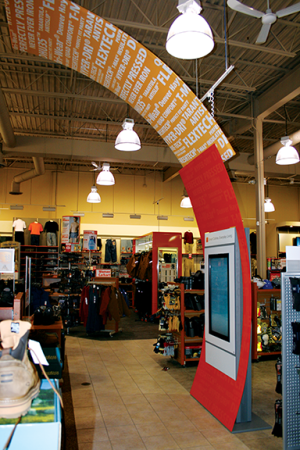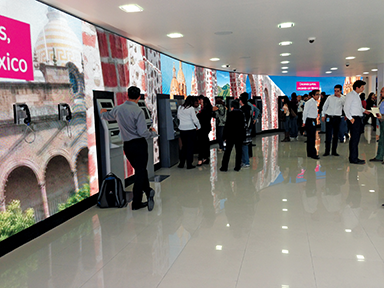Digital Signage: Canada’s hotbed of dynamic media
by all | 2 December 2014 10:49 am
 [1]
[1]Photo courtesy Westbury National
By Lyle Bunn
Digital signage has experienced double-digit growth every year now for more than a decade. Close to two million new networked digital out-of-home (DOOH) displays are deployed annually across North America alone. And Canada, in particular, has been a hotbed of activity for this flourishing industry.
Canada has seen a longstanding focus on media technologies, including protocols and software for audiovisual (AV) post-production, animation, educational applications and game authoring. This history has paved the way to a position of leadership in content management software, which is central to digital signage and related place-based media operations. Indeed, virtually all of the software providers who collectively drive every major digital signage network across North America are Canadian firms or have established engineering offices within Canada, from Capital Networks—known for its Audience brand—in Markham, Ont., and ComQi Canada in Burlington, Ont., to X2O Media in Montreal and ScreenScape Networks in Charlottetown.
Integrators and full operators like Burlington-based AdFlow Networks have combined software, hardware and services for major clients like Mark’s Work Wearhouse. Content producers like Montreal-based Arsenal Media have regularly won ‘best of’ awards in international competitions. Toronto-based GestureTek has been similarly acclaimed for its interactive display deployments.
As the sector has matured, so too has the end user community. These customers have been educated by suppliers and heard their business propositions for many years—some for almost 15 years now—and, as a result, some end users are more knowledgeable of the entire digital signage business model than some suppliers of network components. After all, they need to comprehend the entire technology ‘ecosystem’ that underpins profitable deployments.
Market forces
Many of the largest organizations in major vertical markets in Canada’s highly consolidated economy—including banking, food services, retail and health care—have launched digital signage initiatives in recent years. And while plenty of these are early-stage ‘emerging’ initiatives, they have signalled two important market dynamics.
The first is when the largest organizations within an industry select and use a new medium like digital signage, this can be expected to motivate the next largest firms and aspiring smaller firms to follow suit and move forward with their own digital signage projects.
The second is increasing market pressure requiring contracted suppliers to deliver the promised value in their technology infrastructure, lest they be replaced by better alternatives.
 [2]
[2]High-profile Canadian digital signage software developers include Capital Networks, known for its Audience brand, in Markham, Ont. Photo courtesy Capital Networks
Software developments
One of the world’s leading digital signage software providers is Montreal-based BroadSign International. Before it introduced its products in 2004, software in this field tended to run on expensive media players. BroadSign instead took what was known to the information technology (IT) sector as a ‘software as a service’ (SaaS) approach to its supply model, which facilitated greater scalability and automation.
BroadSign filed for Chapter 11 bankruptcy protection in early 2012, but this move was intended to strengthen the firm—and it worked. The company emerged from the bankruptcy proceedings under the new ownership of the JedFam Group just three months later and won that year’s Global Growth Leadership Award from market research firm Frost & Sullivan in the digital signage software market category.
Jedfam’s president, Burr Smith, became BroadSign’s chair and CEO in 2014. By that point, the company had more than 200 networks running its software on more than 67,000 players in more than 35 countries.
The trend BroadSign started has continued elsewhere in Canada. In Richmond Hill, Ont., for example, iSign Media Solutions has developed proximity marketing SaaS for its ‘smart antennas’ that connect digital signage content in retail stores—including the Mac’s convenience-store chain—to consumers’ mobile devices. Charlottetown-based ScreenScape has taken the content management SaaS concept further in terms of ease of use, to the point where it now markets the notion of turning any TV into a digital sign.
More advanced ancillary features have their roots in Canada, too. Intel’s Audience Impression Metrics (AIM) Suite software, which detects how people react to digital signage, was developed by CognoVision in Markham, which the chipmaker acquired in 2010.
In late 2011, a partnership was formed between Canadian telecommunications provider Telus and software developer Stratacache, which promised to marry a variety of technologies, including social media, wireless communications and digital signage. Stratacache’s Canadian offices are in Montreal, like BroadSign’s. In 2013, Stratacache expanded its Canadian activities further by acquiring Calgary-based Carmanah Signs, which specialized in both ‘static’ and dynamic signs for the lottery and casino industries.
In 2012, digital signage software developer Scala named Toronto-based Dot2Dot Communications—the rebranded Scala Canada—not only its Canadian master distributor, but also the sole proprietor of its Ad Manager platform and related services on a global scale. As such, Dot2Dot acquired the intellectual property of the platform and would handle all further development, sales and worldwide customer support.
“We will help our customers leverage digital signage as an intelligent communications platform that is compelling, attractive, current and interactive and delivers real value,” said Andy McRae, general manager (GM) of Dot2Dot “Our global focus on ad-based networks using Ad Manager will only strengthen the product mix.”
 [3]
[3]AdFlow Networks in Burlington, Ont., has integrated digital signage systems for high-profile clients like Mark’s Work Wearhouse. Photo courtesy AdFlow Networks
Mature and mainstream
Two high-profile examples of the mainstreaming of digital signage were national movie theatre chain Cineplex Entertainment’s acquisitions of Digital Display & Communications (DDC) in Waterloo, Ont., in 2010 and of EK3 Technologies in London, Ont., in 2013.
DDC and EK3 had separately designed, installed and managed digital signage networks for the retail, financial, hospitality and entertainment industries, including such clients as Tim Hortons, McDonald’s, Walmart, Royal Bank of Canada (RBC) and Bank of Montreal (BMO), earning a positive reputation for high-quality service and customer value.
After the acquisitions, DDC was rebranded under the existing Cineplex Digital Media (CDM) banner, while EK3 was renamed Cineplex Digital Networks (CDN). Today, their integrated efforts (see example on page 121) are enhanced by Cineplex’s broader capabilities, including consumer branding, media production, ad sales, multi-channel marketing and facility management.
“The strengths of CDM and CDN will make us a leader in the indoor digital signage industry and provides a platform for significant growth throughout North America,” said Ellis Jacob, president and CEO of Cineplex, in 2013.
Another change that helped accelerate Canadian digital signage market growth was an asset exchange announced between Sharp’s Audio Visual Canada and AVW-TELAV in late 2011. The latter company’s president, Johanne Bélanger, had been monitoring the maturing of digital signage from a variety of vantage points, including her role as international director of InfoComm International, an IT and audiovisual (AV) industry association.
Today, AVW-TELAV’s Canadian operations are known as Freeman Audio Visual. The company has found digital signage success in the past with clients like Toyota and its expanded capabilities have made it an important new supply force within the Canadian digital signage market.
Christie, an AV system manufacturer that invented MicroTile digital signage ‘cubes’ in Kitchener, Ont., acquired Montreal’s Arsenal Media in 2014, with plans to rename it Christie Creative Media Services. The two companies had worked together on many high-profile projects in the past, including an award-winning video wall for Sun Life Financial.
Collaboration nation
Canadians have a propensity for collaboration where broader benefits can be achieved. For digital signage, this has been well-illustrated through industry gatherings and educational events that have helped build beneficial relationships between suppliers and buyers.

Known for applying a software-as-a-service (SaaS) approach to digital signage, Montreal-based BroadSign International now has more than 200 networks running its software around the world, including this bank in Mexico. Photo courtesy BroadSign International
Indeed, it is fair to suggest digital signage education in North America was ‘founded’ by the Toronto-based Strategy Institute, which began running related conferences in 2004 and helped train thousands of professionals. Its CEO, David Laird, was named ‘Digital Signage Man of the Year’ for 2006 by the Digital Signage Forum.
Today, Dot2Dot, LG Electronics Canada and Vertigo Digital Displays are co-sponsors of the ongoing Digital Media in Canada (DMIC) webinar series. Each session focuses on a different foundation of digital signage success.
The Location Based Marketing Association (LBMA) was founded and continues to be headquartered in Toronto, but has expanded internationally in recent years. Its members include software developers, wireless firms, retailers and ad agencies.
LBMA and many others have taken part in Toronto’s annual Dx3 conferences, which have focused on social, local and mobile (SoLoMo) marketing. Dx3 has grown to the point where it is reportedly Canada’s largest conference and trade show dedicated to digital marketing.
In fall 2014, industry veteran Dave Haynes organized a one-day conference in Toronto called ‘DSrupted,’ focusing on how technological developments are causing major changes for digital signage software, data integration, playback devices and other aspects of the industry. Haynes is already planning a 2015 followup event.
The seventh Digital Trends Showcase (DTS) was held in October 2014, profiling advanced—but already available—approaches to dynamic place-based media branding, merchandising, messaging and engagement through 10 demonstration scenarios, all using the same marketing content from Adidas for the purpose of illustration. Some 500 professionals, representing many of Canada’s best-known brands, attended the event.
Through such hands-on and walk-through demonstrations, Canadian customers are kept up-to-date on rapidly evolving applications for marketing, communications and other new uses for digital signage.
Lyle Bunn is a digital signage analyst, consultant and educator based in Brighton, Ont. For more information, visit www.lylebunn.com.
- [Image]: http://www.signmedia.ca/wp-content/uploads/2014/12/Perimeter-Institute-Lobby2.png
- [Image]: http://www.signmedia.ca/wp-content/uploads/2014/12/CNL_Oxford_STC_Promo.png
- [Image]: http://www.signmedia.ca/wp-content/uploads/2014/12/Touch-Screen-2.png
Source URL: https://www.signmedia.ca/digital-signage-canadas-hotbed-of-dynamic-media/